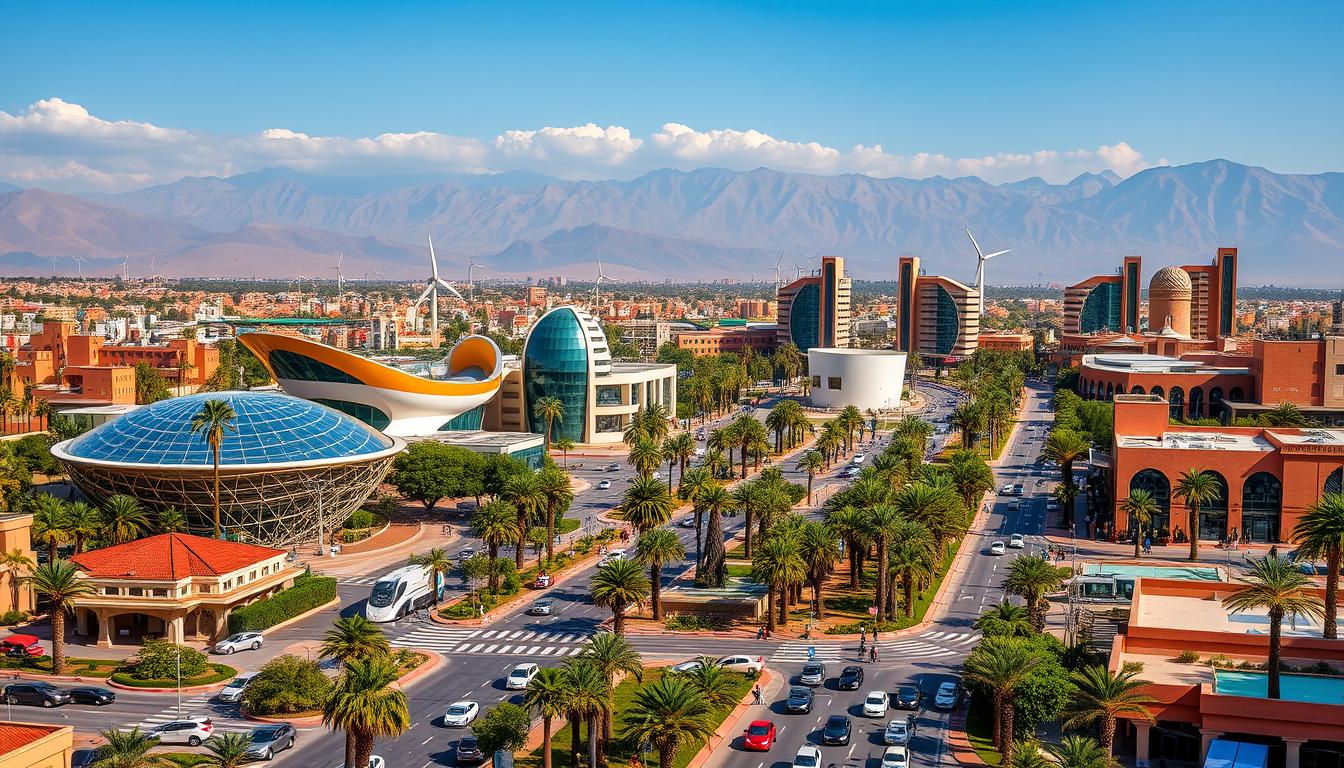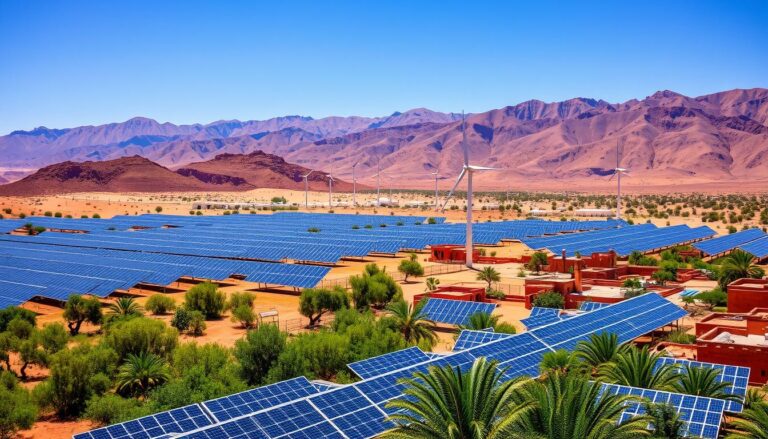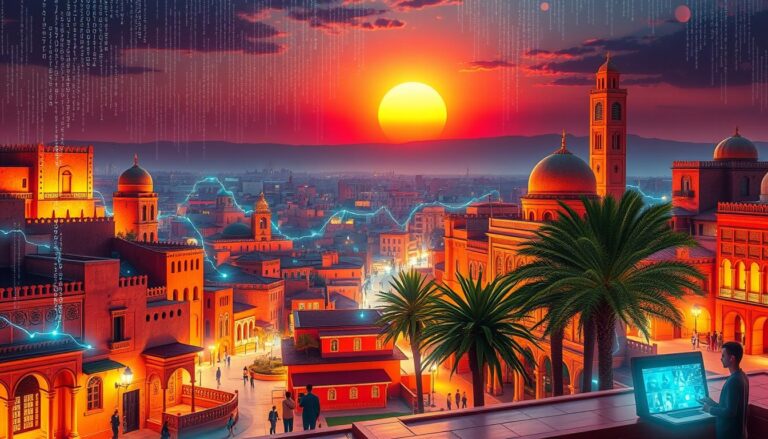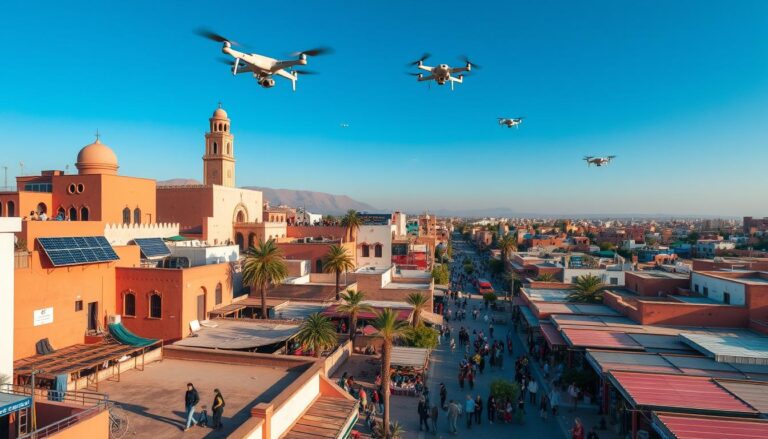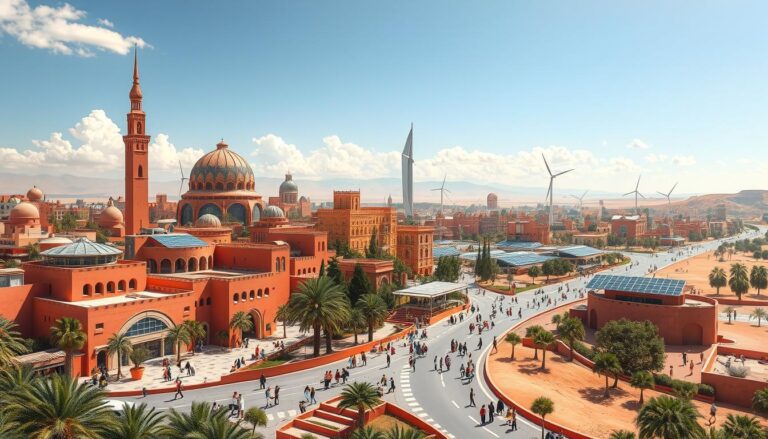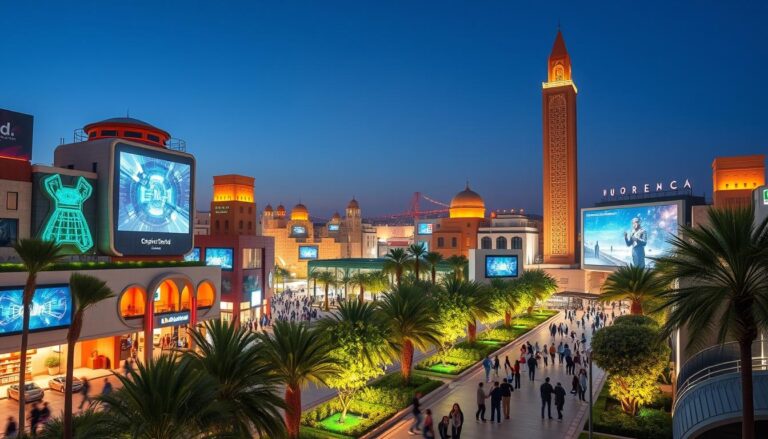Imagine a country ready to change its infrastructure, from top-notch ports to vast high-speed rail networks. How is Morocco planning to close a $37 billion investment gap by 2040?
The Moroccan government is leading a series of big infrastructure projects. This journey aims at sustainable economic growth and unmatched innovation. Key plans include the 2040 Rail Strategy, Vision 2023-2030 for tourism, and the 2030 National Port Strategy. The Noor Ouarzazate solar plan is also part of this agenda.
These efforts show Morocco’s dedication to modernizing its economy and boosting global competitiveness. They plan to invest nearly $4 billion in new infrastructure, with 68% going to transportation.
As Morocco moves forward, it aims to close its infrastructure investment gap and drive sustainable growth. Projects like the Mohammed VI Tangier Tech City and the Noor Ouarzazate Solar Complex will change the nation’s future. They offer a great example for other emerging economies.
The Port of Tangier-Med and its Expansion
The Tangier-Med port is a key part of Morocco’s sea trade. It connects Africa, Europe, the Americas, and Asia. This makes it a vital spot for trade and economic growth.
Overview of Tangier-Med Port
Tangier-Med port is among the world’s top 35 container ports. It handled 5,771,221 TEU in 2020. Its modern facilities and logistics system make it a key hub in the Mediterranean.
Significance of the Expansion
The port’s expansion aims to make it a leading logistics center. Phase 2 added 18 hectares and new container stacks. It also brought in electric cranes and hybrid shuttle carriers to improve efficiency and cut CO2 emissions.
Four new STS cranes can handle big ships. They have an 82-meter outreach and can manage vessels up to 24,000 TEU.
Economic Impact
Morocco’s economy is set to grow with Tangier-Med’s expansion. The port’s capacity has increased by 32.5% since 2020. By 2025, it will handle even more containers.
By then, Morocco will be a major player in global logistics. It has moved up from 84th to 16th in port operations, according to UNCTAD.
The upgrades at Tangier-Med port highlight its importance in global trade. They also show Morocco’s commitment to a seamless logistics system.
High-Speed Rail Developments
Morocco is leading in African infrastructure with its high-speed rail advancements. The Plan Rail Maroc 2040 aims to grow the network by 2024. It plans to add new routes and improve current ones.
The Al Boraq High-Speed Train
The Al Boraq train is a big step for Morocco’s transport. It started in 2018, linking Tangier, Rabat, and Casablanca at 320 km/h. It cuts travel time, boosting the economy and social links.
SYSTRA manages the longest part of this project. Their work shows the teamwork behind this achievement.
2040 Rail Strategy
The Plan Rail Maroc 2040 is a big plan for Morocco’s rail. It aims to grow from 200 miles to 800 miles by 2040. This $37 billion plan will add 2,300 miles of rail, connecting 43 cities.
This will create 300,000 jobs and help 87% of Moroccans. It will make Morocco a key link between Europe and Africa.
New Connections and Future Plans
Morocco plans to extend the high-speed rail to Marrakesh from Kenitra. This project is worth about $348 million. The ONCF is also planning a 375 km route from Casablanca to Marrakesh by 2030.
New tram and bus lines will be added in major cities. Future plans include more rail lines. This will boost the economy and improve connections.
Renewable Energy Initiatives
Morocco is quickly becoming a leader in renewable energy. It has big goals and is investing a lot. The goal is to use more renewable energy, aiming for 52% by 2030 and 80% by 2050.
NoorMidelt Solar Power Plant
The NoorMidelt solar project shows Morocco’s commitment to a green future. It plans to be one of the world’s largest solar power plants, with 800 MW capacity. It uses both solar technologies to make the most of the sun’s energy.
This project has attracted MAD 30 billion (around $3 billion) in investment. It shows Morocco’s strong commitment to renewable energy.
Tarfaya Wind Farm
The Tarfaya wind energy farm is on the Atlantic coast. It’s one of Africa’s biggest wind farms, with 301 MW capacity. The project shows Morocco’s plan to work with the private sector for wind energy.
With Tarfaya, Morocco wants to grow its renewable energy. It currently has around 4.6 GW capacity. Wind energy is a big part of this plan.
Xlinks Morocco-UK Energy Project
The Xlinks Morocco-UK Energy Project is very ambitious. It plans to build an undersea cable to send clean energy to the UK. The cable will be 3,800 km long and have 11.5 GW capacity.
This project will help both countries with their energy needs. It’s a big investment in renewable energy, showing Morocco’s important role globally.
Morocco is a top choice for renewable energy investments. It’s second on Ernst & Young’s Renewable Energy Country Attractiveness Index. Morocco is investing MAD 23 billion (about $2.3 billion) in green energy from 2023 to 2027. The future looks bright and clean.
Major Airport Projects
Morocco is making big changes to its airports to improve travel and boost the economy. The country is investing in new projects to handle more travelers and help local areas grow.
Marrakech-Menara Airport Expansion
The Marrakech-Menara airport development is a key part of Morocco’s airport plans. It aims to grow the airport to welcome more tourists and business people. New terminals, better facilities, and improved navigation systems are part of the project.
This upgrade is important for keeping Marrakech a top tourist spot and a key part of Morocco’s airport network.
Upgradation of Regional Airports
Morocco is also working on its regional airports to meet global standards. This effort is crucial for improving Moroccan aviation infrastructure. The focus is on Tangier’s Ibn Battuta Airport, with big investments and improvements.
New terminals, control towers, and more parking are planned. These changes will make the airport better for travelers and the local community.
- Expansion of the airport fence to 6 kilometers
- Construction of a 55,000 square meter terminal by 2030
- Increased passenger capacity from 1.2 million to 4.4 million per year
- Enhanced amenities such as public concourse areas, shopping facilities, and car parking for approximately 2,300 cars
The goal is to meet and beat safety standards set by the International Air Transport Association. This will lead to safer and more efficient airports across the country.
Morocco Mega Projects
Morocco is making a big push to stand out globally with many mega projects. These projects cover energy, transportation, and urban development. They are attracting a lot of interest from investors worldwide. Thanks to the government’s efforts, Morocco’s infrastructure is changing fast.
The $500-million Casa Marina project in Casablanca is a key example. It’s a luxury, mixed-use area of 450,000 square meters. The goal is to draw more tourists and boost the economy with top-notch facilities.
The Morocco Mall in Casablanca, opened in 2011, is a major attraction. It welcomes around 14 million visitors every year. Yet, despite these big projects, Morocco still faces issues like poverty and slums near Casablanca.
The government is working on a new city called Tamesna. It aims to build 250,000 homes for middle-class and low-income families. However, getting around Tamesna from Rabat is hard, with only one bus line available.
There’s also a problem with real estate speculation. It makes it hard for low-income people to find affordable housing. The government is trying to attract foreign investment to solve these problems.
These projects show Morocco’s commitment to modern infrastructure. The government’s efforts are key to sustainable growth and a strong economy. They are setting the stage for a bright future.
Advanced Urban Planning
Morocco is leading the way in urban planning with big projects. These projects focus on making cities better for people and the planet. They aim to update infrastructure, raise living standards, and protect the environment.
Marchica Med Project
The Marchica Med project shows Morocco’s vision for the future. It’s in the north and plans to turn a lagoon area into a green city. The project includes eco-friendly homes, modern services, and infrastructure that respects nature.
The Marchica Med project is all about keeping the lagoon safe while growing the economy. This is key for Morocco to stay ahead in sustainable city planning.
Cities Embracing Sustainable Growth
Morocco’s push for green cities goes beyond Marchica Med. The Villes sans Bidonvilles Program works to remove slums and improve homes. It’s investing in new tramlines and market areas in cities like Casablanca.
Casablanca is being revamped, showing how to grow cities sustainably. The Wessal Casablanca-Port Program includes a new fishing port and cruise terminal. It also aims to move street vendors to formal markets.
But, these efforts have faced criticism. Some say they ignore local needs. There’s a call for more local input in planning.
Despite these issues, Morocco keeps pushing for green and innovative cities. By focusing on the environment and modernizing, Moroccan cities are setting a high standard for urban development.
Water Infrastructure Development
Water infrastructure in Morocco is key to managing scarce resources. Projects like the Moulay Abderrahmane Barrage in Essaouira and the El Wahda Dam in Taounate are crucial. They help agriculture, industry, and cities by ensuring water security and better distribution.
Moulay Abderrahmane Barrage in Essaouira
The Moulay Abderrahmane Barrage in Essaouira is a vital part of Morocco’s water system. It boosts local farming and gives reliable water to communities. With more rainfall, the barrage helps solve water scarcity in the area.
El Wahda Dam in Taounate
The El Wahda Dam in Taounate is one of Morocco’s biggest reservoirs. It greatly increases the country’s water storage. The dam makes farming more efficient and keeps water flowing to cities.
Morocco’s water policy focuses on big dams and rainwater harvesting. This dam is a big step in fixing the national water deficit, which is currently -29.2%.
Construction and Housing Projects
The Moroccan construction boom has changed the urban landscape. It has led to more housing and modern technologies. This is to solve housing shortages and improve living conditions.
Modern Housing Complexes
The Casa Marina project in Casablanca is a big deal. It’s a $500 million investment in 450,000 square meters. It includes luxury retail, a business center, and high-end apartments.
But, there’s a downside. Urbanization issues are still a problem. Only 10% of Moroccans live in poverty. The boom must help both the rich and the poor.
Also, real estate prices are rising fast. This makes affordable housing hard to find. It’s a big challenge for the construction boom.
New Urban Areas and Smart Cities
Tamesna, 20 kilometers from Rabat, shows Morocco’s vision. It plans to build 250,000 homes for the middle class. But, it only has one bus line, showing the need for better transport.
Smart cities are also on the rise. They use technology to make life better. These cities aim to be sustainable and efficient, marking a new chapter in urban living.
Conclusion
Morocco is changing its infrastructure with big projects. The Port of Tangier-Med and the Al Boraq High-Speed Train show Morocco’s focus on growth. They also highlight the country’s push for green energy, like the NoorMidelt Solar Power Plant.
The Casablanca Marina project shows Morocco’s vision for better cities. It has luxury hotels and offices, making the area more attractive. But, there are worries about who can use these new spaces.
Morocco is set for strong economic growth, with a 4.6% increase expected in 2025. This growth comes from new infrastructure and more exports. But, it’s important to make sure everyone benefits from these changes. Morocco aims to grow while keeping its values and making sure everyone is included.
Source Links
- Morocco – Infrastructure
- Top Mega Projects in Morocco, North Africa
- Morocco Projects – Meed Projects
- APMT MedPort Tangier completes 1 million TEU expansion
- China to build Morocco high-speed rial line for $350 million
- High-speed lines: SYSTRA makes its mark in California and Morocco with two new projects
- Bidders eye Moroccan rail as transformative $37bn project sets off
- Four Reasons Why Morocco Is Becoming a Renewable Energy Powerhouse
- Investment Opportunities in Morocco’s Energy Sector
- The new image of Tangier airport
- Hill Takes up Mega Port Development Work in Morocco – Hill International
- Instant Urbanism Brings ‘Mega Projects’ to Morocco
- Megaprojects, dams and innovative techniques are Morocco’s new weapons in the face of a difficult water situation
- Slum upgrading and urban megaprojects in Casablanca: balancing international competition with local citizens’ needs
- Globalized Authoritarianism and the New Moroccan City – MERIP
- A Strategic Partnership For Morocco’s Water and Infrastructure Development – OpEd
- IFC and OCP Launch Project to Address Water Shortage in Morocco and Food Insecurity in Africa
- Paradigms Lost in Morocco: How Urban Mega-Projects Should Disturb our Understanding of Arab Politics
- Morocco expects economic growth to improve by 4.6% in 2025

The Editorial Team is a passionate group of Morocco enthusiasts dedicated to sharing the beauty, culture, and wonders of this captivating country. With diverse backgrounds and a deep love for travel, we strive to bring you engaging and informative content that inspires your Moroccan adventures. From uncovering hidden gems and sharing local insights to exploring mouthwatering cuisine and showcasing the vibrant lifestyle, our team is committed to providing you with valuable resources and exciting stories that enhance your exploration of Morocco. Join us on this journey as we celebrate the rich heritage and unforgettable experiences that make Morocco truly special.

